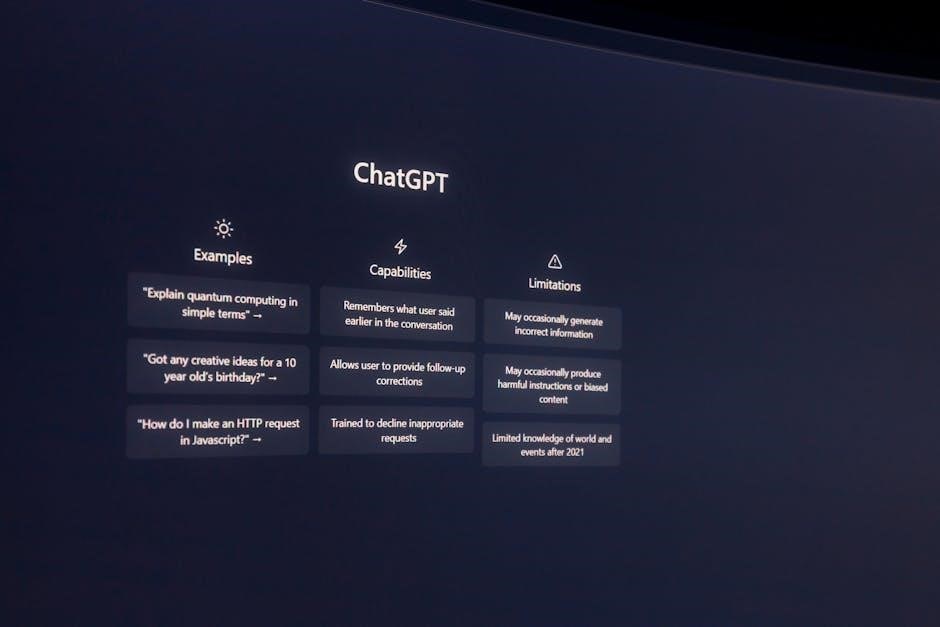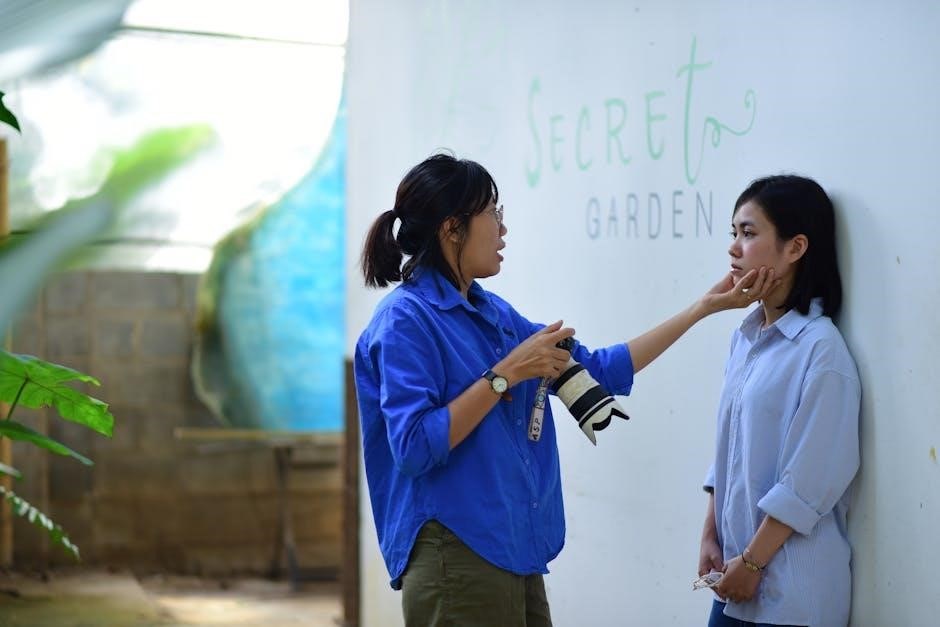Specially Designed Instruction (SDI) involves adapting teaching methods and materials to meet individual student needs‚ ensuring access to learning. It is tailored to address unique challenges and abilities‚ often incorporating assistive technologies and differentiated strategies to promote academic and social growth.
1.1 Definition and Purpose of SDI
Specially Designed Instruction (SDI) refers to tailored teaching methods and materials adapted to meet the unique needs of students with disabilities. Its purpose is to ensure these students access the curriculum and achieve measurable progress. SDI is grounded in legal frameworks like IDEA‚ emphasizing individualized support to address specific challenges and promote academic‚ social‚ and behavioral growth.
1.2 Importance of SDI in Special Education
Specially Designed Instruction (SDI) is crucial in special education as it ensures students with disabilities receive tailored support to access learning. By addressing unique needs‚ SDI bridges gaps in academic and social skills‚ fostering inclusivity and equity. It aligns with legal standards‚ ensuring measurable progress and empowering students to achieve their full potential in a personalized and supportive educational environment.
Legal Framework and Regulations
Specially Designed Instruction (SDI) is grounded in the Individuals with Disabilities Education Act (IDEA)‚ requiring tailored educational programs that meet students’ unique needs‚ ensuring compliance with federal and state standards.
2.1 IDEA and SDI: Key Provisions
The Individuals with Disabilities Education Act (IDEA) mandates Specially Designed Instruction (SDI) as part of a student’s Individualized Education Program (IEP). Under IDEA‚ Sec. 300.39(a)(2)(I)‚ SDI requires adapting content‚ methods‚ or delivery to address unique needs. This ensures students with disabilities receive tailored instruction‚ aligning with federal standards and promoting equitable education. Examples include speech therapy or modified academic strategies.
2.2 State Standards and Compliance
State standards require schools to implement Specially Designed Instruction (SDI) in compliance with federal regulations. Each state outlines specific guidelines ensuring SDI aligns with student IEPs and academic goals. Examples include Indiana’s 511 IAC 7-32-88‚ which mandates adapting content and methods. Compliance involves regular monitoring and documentation to ensure effective delivery of tailored instruction‚ supporting diverse learner needs effectively.
Characteristics of Specially Designed Instruction
SDI involves adapting content‚ methods‚ and delivery to meet unique student needs. It includes tailored strategies‚ assistive technologies‚ and differentiated instruction to address diverse challenges and abilities effectively.
3.1 Adaptation of Content and Methods
Specially Designed Instruction (SDI) involves tailoring content and teaching methods to meet individual student needs. This includes modifying materials‚ pacing‚ and delivery to ensure accessibility. For example‚ using visual aids for visual learners or incorporating assistive technologies for students with physical disabilities. Differentiated instruction strategies‚ such as leveled reading or hands-on activities‚ are also key components of SDI‚ ensuring that all students can engage meaningfully with the curriculum.
3.2 Addressing Unique Student Needs
Specially Designed Instruction (SDI) focuses on tailoring education to address individual student needs‚ ensuring each learner receives targeted support. This includes adapting materials‚ strategies‚ and pacing to accommodate diverse abilities and challenges. For example‚ a student with a speech disability may receive specialized therapy‚ while another with physical limitations might use assistive technologies to access the curriculum effectively.

Examples of SDI in Practice
SDI examples include using assistive technologies for students with physical limitations and providing speech therapy for those with communication challenges‚ ensuring personalized learning experiences.
- Adaptive tools for students with physical disabilities.
- Speech therapy for communication challenges.
4.1 Academic Instruction Examples
Academic SDI examples include adapted content delivery‚ such as using visual aids for students with learning disabilities or providing extended time for assignments. Assistive technologies like text-to-speech software also support access to curriculum materials‚ ensuring students can engage with academic content effectively. These strategies are tailored to individual needs‚ promoting equitable learning opportunities.
- Visual aids for students with learning disabilities.
- Extended time for assignments.
- Text-to-speech software for access.
4.2 Behavioral and Social Skills Instruction
SDI for behavioral and social skills focuses on teaching specific behaviors and social interactions tailored to individual needs. Strategies include Positive Behavioral Interventions and Supports (PBIS) and Social Stories™ to address challenges. These methods help students manage behaviors‚ develop empathy‚ and improve communication‚ fostering a positive learning environment and social competence;
- Positive Behavioral Interventions and Supports (PBIS).
- Social Stories™ for behavior guidance.
- Teaching empathy and communication skills.
4.3 Assistive Technology Integration
Assistive Technology (AT) integration in SDI involves using tools like text-to-speech‚ speech-to-text‚ and augmentative communication devices to support learning. These technologies help students with disabilities access curriculum materials‚ express ideas‚ and complete tasks independently. Examples include screen readers for visual impairments and adaptive keyboards for motor challenges‚ ensuring equitable participation in educational activities.
- Text-to-speech tools for reading support.
- Speech-to-text software for writing assistance.
- Augmentative and Alternative Communication (AAC) devices.

SDI and the IEP Process
SDI is central to the IEP process‚ ensuring tailored instruction and support. It involves collaboration to set goals and monitor progress‚ helping students achieve their goals.
5.1 Developing IEP Goals with SDI
Developing IEP goals with SDI involves creating specific‚ measurable objectives tailored to a student’s unique needs. Educators collaborate with parents to design goals that align with academic and functional skills‚ ensuring progress monitoring. Examples include using assistive technology or behavioral supports to enhance learning outcomes‚ fostering independence and skill mastery.
5.2 Aligning SDI with Student Needs
Aligning SDI with student needs ensures personalized learning experiences. Educators assess individual strengths‚ challenges‚ and learning styles to tailor instruction. This alignment may involve modifying content‚ incorporating assistive technologies‚ or using specific teaching strategies. The goal is to create a customized approach that maximizes student engagement and progress‚ addressing diverse abilities and promoting meaningful educational outcomes effectively.
Instructional Strategies for SDI
Instructional strategies for SDI involve adapting content and methods to meet unique student needs‚ ensuring engaging and effective learning experiences tailored to individual abilities and goals.
6.1 Differentiated Instruction Techniques
Differentiated instruction techniques in SDI involve tailoring lessons to meet diverse learner needs. Strategies include tiered assignments‚ learning centers‚ and scaffolding. Graphic organizers and leveled reading materials are examples. These methods ensure students access content at their individual levels‚ promoting engagement and understanding. Scaffolding techniques‚ such as gradual release of responsibility‚ support skill development. Formative assessments guide instructional adjustments‚ ensuring personalized learning experiences.
6.2 Universal Design for Learning (UDL)
Universal Design for Learning (UDL) provides a framework for SDI by offering multiple means of engagement‚ representation‚ and action & expression. It ensures learning materials are accessible to all students. Examples include multimedia presentations‚ adjustable fonts‚ and interactive tools. UDL aligns with SDI by providing flexibility and accessibility‚ supporting diverse learners in achieving their educational goals effectively.

Assessments and Progress Monitoring
Assessments and progress monitoring in SDI involve regular evaluations to measure student learning and adjust instruction. Tools like formative assessments and data tracking ensure tailored support‚ promoting accountability and improved outcomes for students with diverse needs.
7.1 Formative and Summative Assessments
Formative assessments monitor student progress during instruction‚ while summative evaluations measure learning at the end of a period. Both are crucial in SDI to track growth‚ identify gaps‚ and inform data-driven decisions. These assessments ensure instruction aligns with IEP goals‚ providing actionable insights to adjust teaching strategies and support individual student needs effectively.
7.2 Data-Driven Instructional Decisions
Data from assessments guide SDI implementation‚ ensuring teaching strategies are effective and tailored to student needs. By analyzing progress‚ educators adjust instruction‚ refine goals‚ and allocate resources efficiently. This approach fosters accountability and continuous improvement‚ maximizing student outcomes and ensuring alignment with IEP objectives for personalized learning experiences.
Collaboration and Teamwork in SDI
Collaboration among special educators‚ general educators‚ and parents ensures comprehensive support for students. Teamwork fosters aligned goals‚ shared strategies‚ and consistent implementation of SDI‚ enhancing student outcomes.
8.1 Roles of Special Educators and General Educators
Special educators design and deliver tailored instruction‚ adapting content and methods for students with unique needs. General educators provide support‚ ensuring all students engage in lessons. Collaboration between both roles ensures comprehensive implementation of SDI‚ fostering an inclusive learning environment. Their shared responsibility enhances student access to curriculum and promotes meaningful progress through coordinated efforts and expertise.
8.2 Parent and Teacher Collaboration
Effective collaboration between parents and teachers is crucial for implementing SDI; Regular communication ensures alignment of goals and strategies‚ fostering a supportive learning environment. Parents provide insights into their child’s needs‚ while teachers share expertise in instructional methods. This partnership promotes consistency‚ enhances student progress‚ and strengthens the overall educational experience through shared responsibilities and mutual understanding.

Challenges and Solutions in Implementing SDI
Challenges in SDI include resource constraints and staff training needs. Solutions involve professional development‚ technology integration‚ and collaborative planning to enhance implementation effectiveness and student outcomes.
9.1 Common Challenges Faced by Educators
Educators often face challenges like limited resources‚ lack of specialized training‚ and balancing diverse student needs. Additionally‚ the complexity of collaboration between special and general educators‚ along with the need for data-driven decisions‚ can create barriers. Continuous adaptation to evolving student needs and legal standards further complicates implementation‚ requiring ongoing professional development and support.
9.2 Strategies to Overcome Implementation Barriers
To address challenges‚ educators can engage in professional development programs‚ fostering collaboration between special and general educators. Leveraging digital tools and assistive technologies enhances instruction delivery. Regular progress monitoring and data analysis inform decision-making‚ while building strong partnerships with parents ensures aligned support. Utilizing available resources and maintaining open communication channels further facilitate effective SDI implementation.

Technology and SDI
Technology enhances SDI by providing digital tools and assistive technologies‚ making learning accessible and engaging for students with diverse needs.
10.1 Digital Tools for SDI Delivery
Digital tools like text-to-speech software‚ interactive learning platforms‚ and adaptive technologies enable personalized instruction. These tools adapt content to meet diverse needs‚ enhancing engagement and accessibility for students with disabilities‚ ensuring effective SDI delivery in various educational settings.
10.2 Online Resources for SDI Planning
Online resources such as printable worksheets‚ PDF guides‚ and educational handbooks provide structured support for SDI planning. These tools offer practical examples and templates‚ helping educators design tailored instruction that aligns with student needs and legal standards‚ ensuring effective implementation of specially designed instruction in diverse educational environments.

Case Studies and Success Stories
Real-world examples highlight SDI’s impact‚ showcasing how tailored instruction transforms student outcomes. Success stories demonstrate effective strategies‚ tools‚ and adaptations that foster academic and social growth in diverse learners.
11.1 Real-World Examples of Effective SDI
Real-world examples of SDI include tailored instruction for students with specific needs‚ such as speech therapy integrated into academic lessons or using assistive technology to enhance learning. For instance‚ a student with a speech and language disability may receive SDI through structured communication exercises embedded in classroom activities. Similarly‚ a math lesson might incorporate visual aids and hands-on manipulatives to support understanding‚ demonstrating how SDI can be effectively implemented across various subjects and settings to promote student success and engagement.
11.2 Student Outcomes and Progress
SDI leads to measurable improvements in students’ academic and social skills. For example‚ a student with a speech disability may show enhanced communication through structured exercises. Progress is tracked via data-driven assessments‚ ensuring tailored instruction evolves with student needs. Effective SDI fosters independence‚ confidence‚ and skill mastery‚ ultimately preparing students for long-term success in education and beyond.
Professional Development for SDI
Professional development for SDI includes training programs and continuous improvement practices‚ ensuring educators stay updated on effective strategies and resources‚ like handbooks‚ to enhance instructional delivery.
12.1 Training Programs for Educators
Training programs for educators focus on enhancing skills in delivering Specially Designed Instruction (SDI). These programs often include workshops‚ webinars‚ and hands-on activities to explore strategies like differentiated instruction and assistive technology integration. Resources such as handbooks and guides provide practical examples‚ helping educators adapt instruction to meet diverse student needs effectively while aligning with IEP goals and legal standards.
12.2 Continuous Improvement in SDI Practices
Continuous improvement in SDI practices involves ongoing professional development and reflective teaching. Educators use data-driven insights to refine their methods‚ ensuring alignment with student needs and legal standards. By staying updated on best practices and incorporating feedback‚ teachers enhance the effectiveness of Specially Designed Instruction‚ fostering better student outcomes and adherence to educational regulations.

Cultural Responsiveness in SDI
Cultural responsiveness in SDI involves adapting instruction to include diverse perspectives‚ ensuring inclusivity and equity. It fosters a learning environment that respects and values all students’ backgrounds and experiences.
13.1 Addressing Diverse Learner Needs
Cultural responsiveness in SDI involves adapting instruction to include diverse perspectives‚ ensuring inclusivity and equity. It fosters a learning environment that respects and values all students’ backgrounds and experiences‚ addressing their unique cultural‚ linguistic‚ and individual needs. This approach integrates students’ languages‚ cultures‚ and backgrounds into lessons‚ making learning relevant and engaging. Examples include using multicultural materials and bilingual resources to support diverse learners effectively.
13.2 Culturally Responsive Teaching Practices
Culturally responsive teaching integrates students’ cultural backgrounds into instruction‚ enhancing engagement and understanding. Teachers use diverse texts‚ incorporate students’ languages‚ and connect lessons to their lives. This fosters inclusivity‚ builds trust‚ and ensures all students feel valued. By reflecting student identities‚ these practices promote academic success and social growth‚ aligning with SDI principles to meet diverse learner needs effectively and respectfully.

SDI and Multi-Tiered Systems of Support (MTSS)
SDI aligns with MTSS by providing targeted support within tiered instruction. It ensures students receive tailored interventions‚ integrating academic and behavioral strategies to address diverse needs effectively.
14.1 Integration of SDI with MTSS
SDI seamlessly integrates with MTSS by providing tailored interventions across tiers. In Tier 1‚ SDI enhances universal instruction‚ while Tiers 2 and 3 offer targeted and intensive support‚ ensuring alignment with student needs. This integration ensures a cohesive system‚ leveraging assessments and collaboration to maximize student outcomes and progress monitoring within the MTSS framework.
14.2 Tiered Instructional Strategies
Tiered instructional strategies within MTSS provide a structured approach to delivering SDI. Tier 1 offers universal access‚ Tier 2 adds targeted support‚ and Tier 3 delivers intensive interventions. These tiers ensure that instruction is differentiated‚ with SDI tailored to meet individual needs‚ fostering inclusivity and maximizing student progress through a layered‚ evidence-based framework.

Resources for SDI Implementation
Handbooks‚ guides‚ and examples provide practical support for SDI. Resources like Appendix A and B offer instructional strategies‚ while PDF guides detail lesson planning and delivery methods.
15.1 Printable Worksheets and Templates
Printable worksheets and templates are essential tools for implementing SDI. They provide structured activities tailored to individual needs‚ such as math exercises or reading comprehension. These resources often include adaptable lesson plans and activity sheets‚ allowing educators to customize instruction. Templates may also incorporate visual aids and hands-on tasks‚ ensuring engagement and accessibility for diverse learners.
15.2 PDF Guides and Handbooks
PDF guides and handbooks offer comprehensive resources for SDI implementation. They provide detailed examples‚ lesson plans‚ and strategies for adapting instruction. These documents often include checklists‚ legal considerations‚ and best practices‚ serving as invaluable tools for educators. Handbooks may also cover assessment techniques and progress monitoring‚ ensuring alignment with student needs and educational standards.
Specially Designed Instruction (SDI) is a student-centered approach tailored to meet unique needs. Future directions include advancing technology integration and innovative teaching strategies to enhance learning outcomes.
16.1 Summary of Key Points
Specially Designed Instruction (SDI) is tailored to meet students’ unique needs through adapted content and methods. It aligns with legal frameworks like IDEA‚ ensuring access and progress. SDI integrates assistive technologies‚ behavioral supports‚ and collaborative practices. By addressing diverse learning requirements‚ SDI fosters inclusive education‚ promoting academic and social growth. Its effectiveness lies in personalized approaches and continuous adaptation to student needs and advancements in educational practices.
16.2 Evolving Practices in SDI
SDI continues to evolve with advancements in technology and educational research. Digital tools enhance personalized learning‚ while Universal Design for Learning (UDL) frameworks expand accessibility. Cultural responsiveness and trauma-informed practices are increasingly integrated‚ ensuring inclusive instruction. Ongoing professional development and data-driven approaches refine SDI delivery‚ fostering better student outcomes and equitable education for all learners with diverse needs and abilities.
